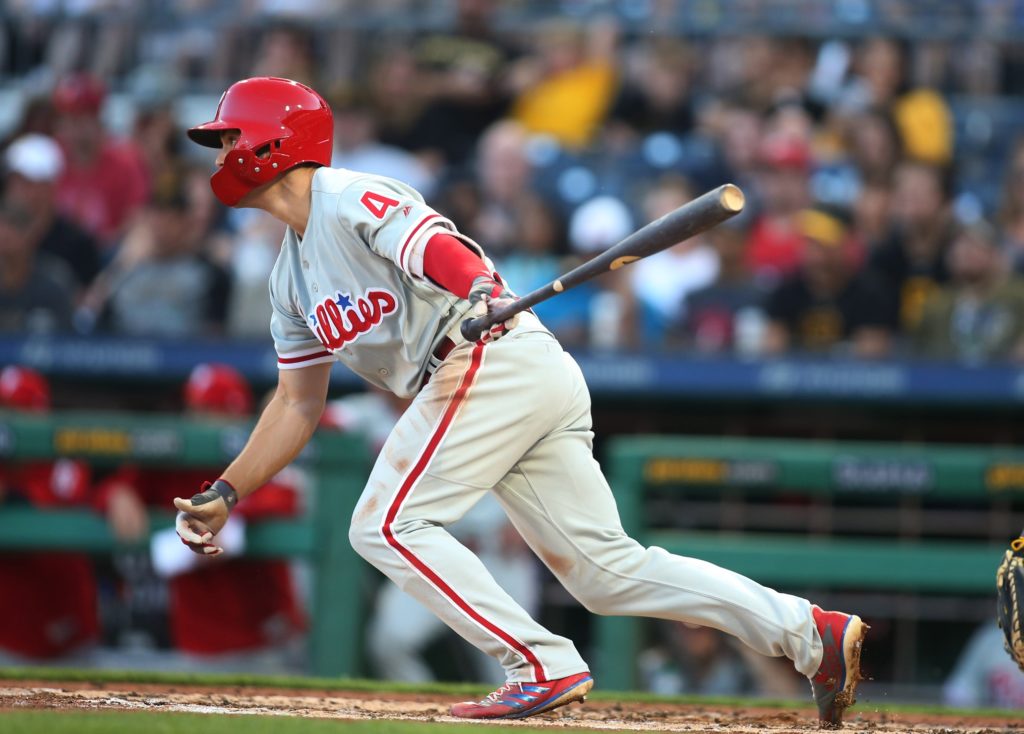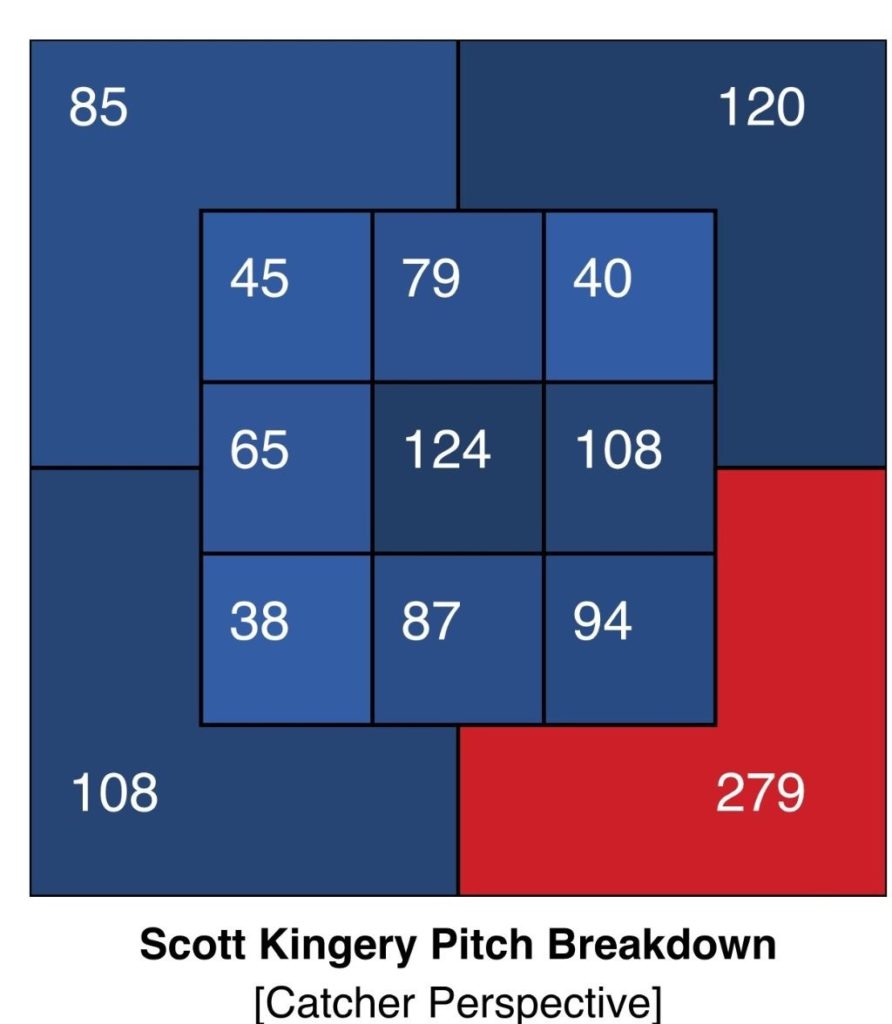Ad Disclosure
A Deeper Look at What’s Behind Scott Kingery’s Offensive Struggles
By Bob Wankel
Published:

It’s been only 108 days since Phillies shortstop Scott Kingery signed a contract that guaranteed him $24 million through the 2023 season. The 23-year-old put an exclamation point on his rapid ascension through the organization’s minor league system this past spring training by slashing .411/.441/.786. He totaled five homers and 10 total extra-base hits in 56 at-bats (an absurd one XBH per every 5.6 at-bats) to go along with a gaudy 1.226 OPS. This on the heels of a breakout 2017 season split between Reading and Lehigh Valley in which he posted an .889 OPS. And while the optimism brought by the news of his long-term deal and the excitement created by one scout’s favorable comparison of Kingery to Dustin Pedroia are not yet even four months old, those positive vibes couldn’t feel further away a mere 86 games into his Major League career.
It’s been a rough opening act for Kingery, who has struggled to the tune of a .229/.277/.333 slash line. He enters play today with a National League-worst .611 OPS among qualified shortstops. That he isn’t a shortstop by trade, or that he’s played six different positions this season, may be possibly contributing to these uninspiring numbers, but it’s hard to say to what extent, if any, that is the case.
Before we continue, it’s important to remember that while Kingery has certainly underwhelmed just over three months into his rookie campaign, it would be completely asinine to write off a player or make any sweeping judgments about his ability to hack it in the big show after only 321 plate appearances. Still, simply attributing his slow start at the plate to defensive discomfort or general inexperience is a bit of an oversimplified blanket narrative. There are mechanical, approach, and pitch recognition flaws that opposing pitchers have routinely exploited when facing Kingery this season, and he’s going to have to make adjustments to become the difference-making spark plug player that the Phillies surely still believe he can be.
I’ve watched nearly all of Kingery’s 300-plus plate appearances this season, and it seems that pitchers want to attack him away; specifically, low and away. My supposition for nearly two months has been that Kingery is having a difficult time recognizing off-speed pitches on the outer-half and beyond, often whiffing or rolling over to create weak contact. His second inning at-bat last night perfectly encapsulated my thesis:
I think this Scott Kingery AB best exemplifies his struggles this season. He fails to recognize the slow stuff on the outer half, weakly rolls over. He needs to adjust on this specific pitch and stay middle. pic.twitter.com/K6I2xUTEcF
— Bob Wankel (@Bob_Wankel) July 10, 2018
To be fair, that swing occurred on an 0-2 count, so Kingery has to protect in that spot, but he failed to recognize and time what wasn’t a particularly impressive 77.3 mph curveball that was also out of the strike zone. That swing sent me down a rabbit hole in an effort to explore if the numbers supported what my eyes were telling me. Here’s what I found.
To begin, I wanted to see if pitchers are, in fact, attacking Kingery low and away. They are:
Kingery has seen 1,272 pitches this season. Of them, 341 pitches (26.8%) have been on the inner part of the plate or beyond it, 290 (22.8%) have been in the center of the zone, and 641 (50.4%) have been on the outside part of the plate or beyond it. That’s not a coincidence. Looking at the above chart, you’ll see that opponents have indeed attacked him away, particularly low and away, and it’s working:
graphs courtesy of Baseball Savant
He most frequently sees pitches in a location where he’s not making consistent contact. He’s whiffed on 52% of pitches that are low and outside of the zone (Figure 4) and when he does make contact, he is only producing a 73.5 mph exit velocity (Figure 1). That typically isn’t going to produce a desirable outcome for a hitter, so it’s of little surprise that he’s hitting .196 (Figure 3) with a brutal .022 ISO (Figure 2) against pitches in that particular zone. As these charts illustrate, he’s also struggled, albeit to a lesser degree, against pitches that are elevated and away.
So why is this happening and how does he fix it?
This is where I think inexperience and other contextual factors do come into play. He appears to be overanxious and struggling with pitch recognition, and is therefore struggling to stay up the middle or go the other way with pitches on the outer half of the plate. His high whiff rates and weak contact like the kind shown in the video embedded above suggest that Kingery is too often out in front of pitches. A deeper dive into the numbers supports this premise.
While he has had some success against curveballs this season, particularly ones that stay middle or are on the inner half of the plate, he’s posted a miserable .496 OPS in 73 at-bats that end against a slider and an even worse .230 OPS in 30 at-bats ending with a changeup, according to FanGraphs. What’s more, according to Statcast, his 36.8% chase percentage is 8.6 points higher than the Major League average this season. Such numbers are often symptomatic of a player who doesn’t trust his hands, or one that is trying to do too much. Now, I haven’t met Scott Kingery, so I can’t speak to his personality, but I don’t think it’s far-fetched that a talented but struggling young player who is universally regarded in baseball circles as a tireless worker might be pressing as he tries to make good on an unprecedented contract. And, oh yeah, he’s trying to do this while also under the microscope as a middle-of-the-lineup hitter on a first-place team.
At the very least, Kingery’s track record and offensive abilities are good enough that it’s hard not to imagine with more experience that he will:
1. Identify how pitchers are attacking him and make a conscious effort to take more pitches the other way
2. Stop pressing, let the game slow down, and, in turn, trust his hands and let the ball get deeper
So what should the team do as he tries to figure this out? Well, I think it’s important to remember that he didn’t just forget how to hit. He wouldn’t have he gotten this far if he couldn’t hit an outside pitch. As such, I think the main thing is remaining patient when it comes to his progression. I don’t think it would do much for his confidence or his long-term growth to send him back to Lehigh Valley at this point. What the Phillies must decide, however, is if they can afford to ride with him as their everyday shortstop as the intensity and pressure of each game is sure to continually increase over the season’s final two-and-a-half months. They may ultimately elect to do just that, but the roster is still thin enough that they could still get him somewhat frequent at-bats by utilizing him much the way they did earlier in the season. With J.P. Crawford’s eventual return, a suddenly red-hot Maikel Franco experiencing an unexpected renaissance, and the rumor mill churning ahead of the July 31 trade deadline, the Phillies will have options. Regardless of what they ultimately elect to do over the remainder of this season, Kingery should still very much be part of the short and long-term plan. There’s just too much talent there to think that these issues won’t be fixed.
Bob Wankel covers the Phillies for Crossing Broad. He is also the Vice President of Sports Betting Content at SportRadar. On Twitter: @Bob_Wankel E-mail: b.wankel@sportradar.com

